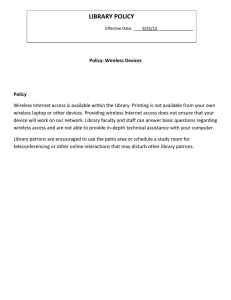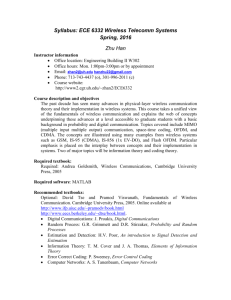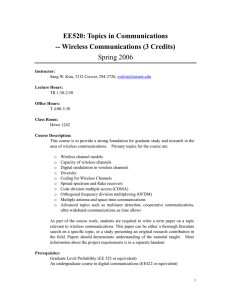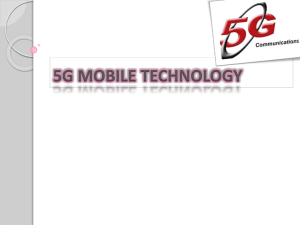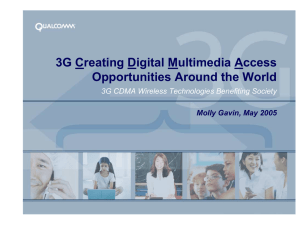EE 520: Topics in Communications - Wireless Communications Lecture 1
advertisement
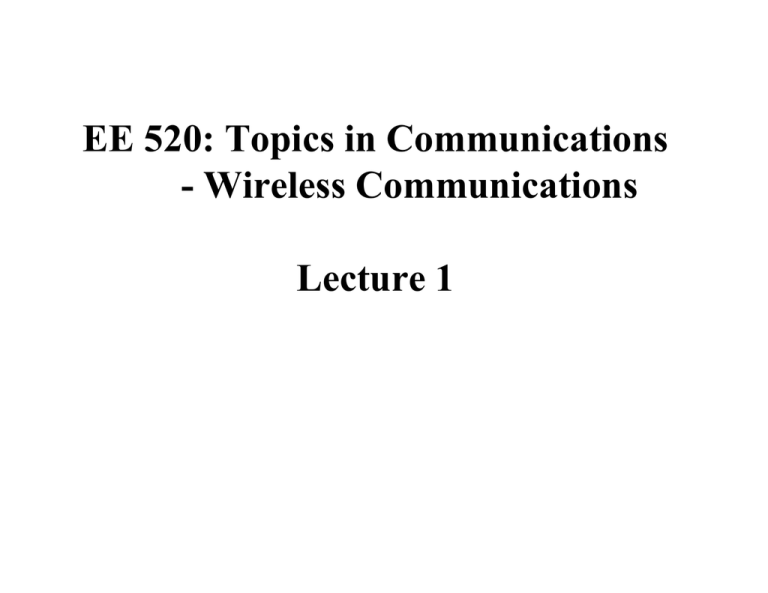
EE 520: Topics in Communications - Wireless Communications Lecture 1 Course Information • Instructor: Sang W. Kim – swkim@iastate.edu – 3112 Coover – 515-294-2726 • Lecture Time: TR 2:10-3:30 Æ Moved to TR1:30-2:50 • Class Room: 1242 Howe • Office Hours: T 4:00-5:30 2 Course Information • Prerequisites: – Graduate Level Probability (EE 523 or equivalent) – An undergraduate course in digital communications (EE422 or equivalent) • Class Homepage: – http://www.public.iastate.edu/%7Eswkim/ee520.html – All handouts, announcements, homeworks, etc. posted to website • Textbook: – Andrea Goldsmith, Wireless Communications, Cambridge University Press, 2005 3 Course Information • References: – D. Tse and P. Viswanath, Fundamentals of Wireless Communication, Cambridge University Press, 2005. – T. S. Rappaport, Wireless Communications - Principles and Practice, 2nd Ed. Prentice Hall, 2001. – S. Verdu, Multiuser Detection, Cambridge: 1999. – A.J. Viterbi, CDMA: Principles of Spread Spectrum Communication, Addison-Wesley 1995. – M.K. Simon, J.K. Omura, R.A. Scholtz, and B.K. Levitt, Spread Spectrum Communications Handbook, McGraw-Hill 1994. – J.G. Proakis, Digital Communications, 4th Ed., McGraw-Hill: 2001. – M. K. Simon and M.-S. Alouini, Digital Communications over Fading Channels, A Unified Approach to Performance Analysis, Wiley: 2000. 4 Topics • • • • • • • • • • Wireless Channel Models Capacity of Wireless Channels Digital Modulation in Wireless Channels Diversity Coding for Wireless Channels Spread spectrum and Rake receivers Code division multiple access (CDMA) Orthogonal frequency division multiplexing (OFDM) Multiple antenna and space-time communications Advanced topics such as multiuser detection, cooperative communications, ultra-wideband communications as time allows 5 Course Information • Grading: – – – – Homeworks:10% Exam I: 30% Exam II: 30% Project: 30% 6 Project Information • One of the most important aspect of this course • Project on anything related to wireless communications • Literature survey, analysis, or simulation – Survey: • Summarizing and comparing the main ideas, concepts, and results presented by other authors • maximum grade capped at 85%. – Analysis/Simulation: • start early, discuss with me. • two can collaborate, but this will naturally increase the expectations for the scope and quality of the project. 7 Project Information • Picking an appropriate problem is one of the more challenging aspects of research – It is suggested that you browse current literature such as IEEE Communications Magazine, IEEE Wireless Communications Magazine, and recent conference proceedings. • A project proposal should consist of – a tentative title – a clear and brief description of what you intend to investigate – what you hope to discover or accomplish – a list of relevant references. – about a page long in total 8 Project Information • The project report should be in the format of – – – – – Abstract Introduction Methodology, analysis, simulations Conclusions References • Abstract and introduction should frame and motivate the work and convince the reader that the research is valuable and worth the effort to read. • Not to exceed 10 pages (12pt, single column). 9 Project Information • Due Dates: – Proposal: March 21 – Final Report: April 28 • Grading Policy: – Proposal (15%): • Clarity of objectives, ambitious but achievable objectives • Relevance of proposed research • Appropriateness of cited literature. 10 Project Information – Final Report (85%): • Originality (25%): Is this new work, how creative is the idea, how creative is the solution, how general is the solution? • Organization (25%): Good flow of explanation, proper use of figures, easy to follow development of your ideas, easy to identify your contributions? • Technical Content and Execution (25%): Are the technical contents strong and thorough? How well do you deliver on your proposal, how well do you accomplish the claims made in the abstract, how clear is your analysis, does this work thoroughly cover the proposed area? • References (10%): All relevant research cited, good discussion of previous state-of-the-art? 11 Project Information • Some Potential Project Areas (but not limited to): – – – – – – – – Multi-carrier modulation and OFDM A comparison of diversity techniques Adaptive modulation for CDMA and OFDMA MIMO systems Multi-user detection, Interference cancellation Power control for CDMA systems Handoff algorithms for cellular systems Capacity analysis (including multiple cells, fading, multipath) – – – – – – – Software-defined radios Sensor networks Energy constrained communications RFID technology Cross-layer design for ad hoc networks Multi-mode handsets (Wireless LAN and cellular) Hybrid multiple access techniques for uplink/downlink (e.g. CDMA uplink, OFDMA downlink) – Cooperative communications – Ultrawideband (UWB) systems – Cognitive radios 12 • Overview of Wirless Communications [http://www.stanford.edu/class/ee359/lecture 1.ppt] 13

